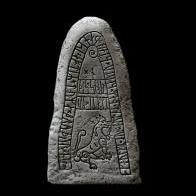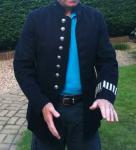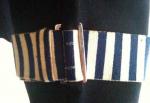
bengullion
For Deletion-
Posts
22 -
Joined
-
Last visited
bengullion's Achievements
-
Hi The city police armlet which is still in use was similar to that of the Met. If you are familiar with how it fastened it was through a loop on the sleeve of the jacket. Holding the alley to the sleeve was a metal buckle otherwise it would spin round the sleeve. The later armlets had a stud fastening at the end where the material came to a point.it secured the end from flapping about although one could fix it under the buckle to prevent it flapping. I think yours may be for sale without a buckle which is essential to fix the armlet thro the loop on the sleeve. Contrary to opinion the armlet was not a hazard in a struggl. Best wishes Bengullion
-
May I make a couple of observations about this uniform jacket apparently worn in Australia. Senior officers of Commander (Met) and A.C.(Provinces) rank and above in England traditionally have a jacket made with a belt and patch pockets. This jacket shown has none. It appears to have a flap pocket built in to the tunic. It may have been a one off that Wood had made for himself. I know that the present Met Commissioner dislikes belts and has chosen to wear a jacket issued to constables to ch.supts. It has no belt and has only breast pockets. It looks alright except that the rank insignia does not appear comfortable without resting on an epaulette. That said he has it appears, commissioned a new No1. dress uniform ( mounted) with all the threaded silver work. Looks very good and I know he likes riding a horse - pity that few of his recent forerunners didn't. I saw recently displayed on the forum ( can't find it now) a newly coloured photo of the Met Commissioner Sir Charles Warren ( Jack the Ripper fame) wearing his full dress tunic. It looked great. Sadly modern man eschews all such trappings even on ceremonial occasions and outside the Met and the City ( that real bastion of tradition) police ceremonial dress consists of white gloves. How sad. Bengullion
-
The Met was essentially organised into departments ABCD up until the re-organisation by Commissioner Newman in t he 1980s. B department or branch had responsibility for transport including traffic police, communications within the Force ( Information Room at NSY which dealt with 999 calls), lost property, public carriage office ( Cabs) It also supervised public utilities roadworks.The transport of prisoners to and from police stations, courts, prisons etc. In all a host of admin functions that did not fall readily into "A" department - operational uniform policing, "C"- Crime, intelligence, investigation and "D" personnel and training. The departments of the Met did not change in their designations from Edwardian times until Newman. Obviously their functions expanded and changed in detail but their core functions remained unaltered. Hope this helps. Bengullion
-
Ilford Division was one of the chosen divisions to trial the new uniform in the Met. It did have a badge on the left breast detachable as I recollect. Somewhat similar to the Franch national police badge The tunic did not have a belt. Standard issue tunics at that time did so. Women police were also trialling at this time a new style uniform.I had a female officer at Walthamstow who modelled the new uniform. The male version was not adopted by the Met but the style was the forerunner to the tunic now used today by the Met as No.1. dress uniform. Sadly, Robert Mark ( Commissioner) abolished the proper No.1 dress uniform worn by the Met at all State occasions. Having witnessed the State funeral of Commissioner Waldron who died in office and was buried with full honours - boots reversed in stirrups etc.Having coming from a county police he had no sense of tradition. He got rid of the lot. What a tragedy ! The substitute tunic No. 1 dress was on parade at the Queens Golden Jubilee celebrations in The Mall. I saw the present Commissioner was mounted in full dress regalia with cocked hat although he appears to have commissioned a new dress tunic. bengullion
-
I recollect that a photograph of a silver token was shown in the Instruction Book so that an unwitting P.C. would not wonder what it was if exhibited by a plainclothes (senior officer). When and if the token was abolished I do not know. The D.A.C. rank in the Met was reintroduced when the senior ranks were revised in the late 60's, early seventies. Prior to the revision the Commander rank in the Force was immediately below that of the Assistant Commissioners. Their importance was reflected that they governed each of the four Districts of the MPD and had deputy commanders as subordinates. Chief Superintendents were in charge of the old divisions with a Superintendent i/c of each sub-division. E.G. the old "H" division even in the 1960's was known as "H" or Whitechapel Division. Chief Superintendent's rank at that time was designated by a crown and 2 bath stars. Superintendents a crown and one star. At the time of the re-structuring the Met upgraded over a couple of years all Ch.Supts to Commanders who became i/c of Divisions. The rank insignia of Ch.Supts and Supts fell in line with that of the Provinces - 1 crown and 1 bath star (Ch.Supt) and Supt ( a crown). The dormant rank of DAC was re-instituted. I think it had been abolished in the 1930s. The rank of deputy Commander was also abolished at this time. I have a recollection that these changes occurred at the start of the Troubles in N.I. as the R.U.C. chief supt was allowed to retain the old insignia so that he equated to a full colonel in the military with whom they were having a great deal of liaison and to the military rank is everything.
-
Concerning the comment on the right cuff of the overcoat appearing to show the remains of a sleeve band or cuff title. I have a copy of John Angolia's book on the German Police. Vol 2 page 119 displays a police officer in greatcoat displaying a sleeve cuff on both arms. These are illegible but it is the brown collar pattern coat. Sid
-
Well slight exaggeration to say it still fits. I am long retired living in north Essex, but have happy memories of the Met which I am proud to have been a member. I knew that part of the East End very well lived in the section house at HH. Patrolled many a night on foot as aid to "HI" and like you knew the docks and the places to get a cup of tea. Sorry for the delay in responding, I dont access the site very frequently.
-
I am pleased that some have found my comments useful. I was a young PC in the early sixties at "HP" Poplar. Long since closed and demolished but part of "HH" sub-division Most serials in those days from outer London divisions travelled by tube into central London. The serial inspector was issued with a bulk travel warrant ( no free tarvel in those days) which provided him with a tickets for all to travel on the underground. I note the comments on the armlets and how they were attached. I have included a photo of mine attached to my original No1. uniform. I see on many films of that period that the armlet is wrongly attached to the cuff and a loose end is flapping about. Mine isn't as you will see it is properly attached. I have no recollection of officers finding the armlet an encumberance when in a tussle or an anchor for a villain to hold onto, however no doubt it was pulled off at some time. As you can see this was made to measure when I was 19 and it still fits. Well almost ;)
-
The wearing of the armlet indicated as has already been said that the officer was "on duty" i.e. booked on. I remember as a young P.C.many times travelling with a serial of officers 18PCs, 2 Sghts on the underground from the East End to a demo in central London and the inspector i/c directed that the armlet would be removed until on "ground assigned" in central London. In addition when the officer was Off duty and the armlet removed he could enter a public house and consume alcohol in uniform. The removal of the armlet to deceive a landlord was a further discipline offence if in fact the officer was on duty. These regulations stem from the period when police were not allowed to wear mufti and were always dressed in uniform. The regulations changed with the licensing act in 1964 if I remember correctly. S.MacKay
-
Thanks for the information it is most useful.
-
Thanks for hte response you have confirmed my thoughts.
-
I though Catholics did not as a rule join freemasonary ?





